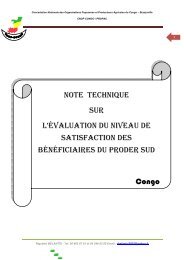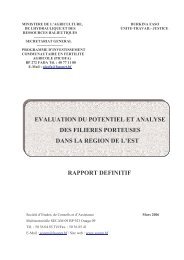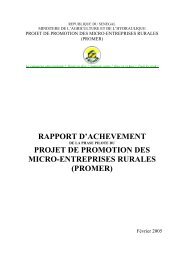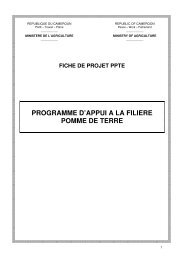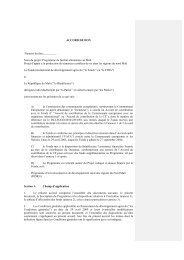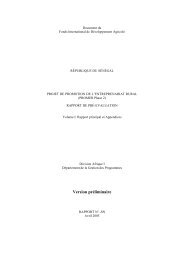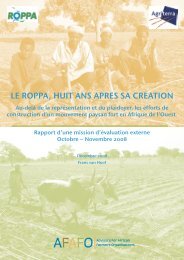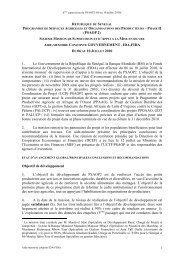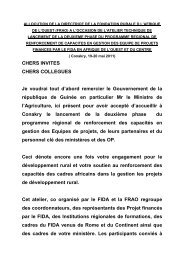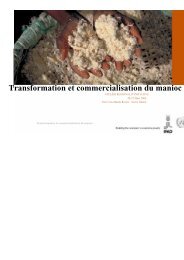Scaling Up the Fight Against Rural Poverty - FIDAfrique
Scaling Up the Fight Against Rural Poverty - FIDAfrique
Scaling Up the Fight Against Rural Poverty - FIDAfrique
Create successful ePaper yourself
Turn your PDF publications into a flip-book with our unique Google optimized e-Paper software.
E. The Portfolio Review<br />
IFAD’s management undertakes annual, in-depth portfolio reviews to assess <strong>the</strong> health of <strong>the</strong> project<br />
portfolio under implementation. Annually guidelines are issued for <strong>the</strong>se portfolio reviews. They<br />
provide instructions on how regional divisions should conduct <strong>the</strong>se reviews.<br />
In comparison to o<strong>the</strong>r operational instructions, <strong>the</strong> guidelines for portfolio reviews quite prominently<br />
emphasize scaling up issues. Reference to scaling up is made in several sections. Very importantly,<br />
scaling up is not only presented as an addendum to innovation, but is presented as an issue in its own<br />
right. The emphasis on scaling up is particularly evident in <strong>the</strong> ratings. Each project is to be rated on its<br />
“potential for scaling up and replication”. This rating is given separately from innovation/learning.<br />
Ratings between 1 and 6 are assigned. (See Box 6) While <strong>the</strong> inclusion of a rating on potential for<br />
scaling up and replication is a welcome development, in due course a revision of <strong>the</strong> criteria for <strong>the</strong><br />
rating might be needed. The potential for scaling up should not be assessed based only on <strong>the</strong> fact<br />
whe<strong>the</strong>r a partner has shown interest. More important are considerations on how far <strong>the</strong> project has<br />
advanced on <strong>the</strong> pathway to scaling-up. Interest of development partners is an important, but not <strong>the</strong><br />
only, indicator for potential for scaling up.<br />
Box 6. Portfolio Review ratings for scaling up<br />
“An assessment should be made of <strong>the</strong> extent to which <strong>the</strong> project is positioned to translate its approach<br />
and/or innovations at <strong>the</strong> local level onto a larger scale – by government bodies, donors, o<strong>the</strong>r national/local<br />
partners, or poor women and men and <strong>the</strong>ir organizations.<br />
(6) Highly satisfactory. Development partners have already begun scaling up certain elements.<br />
Strong potential exists for scaling up or replicating both at national level and beyond.<br />
(5) Satisfactory. Development partners have shown interest in certain elements. Good potential for<br />
scaling up exists, but mainly within country.<br />
(4) Moderately satisfactory. Development partners have shown some interest in selected project<br />
initiatives. Some potential exists for scaling up within country.<br />
(3) Moderately unsatisfactory. Development partners have shown little interest in <strong>the</strong> project. Limited<br />
potential for scaling up exists, mainly at <strong>the</strong> local level.<br />
(2) Unsatisfactory. Slight potential for scaling up exist, only at <strong>the</strong> local level.<br />
(1) Highly unsatisfactory. No potential for scaling up.”<br />
Source: IFAD (2009c)<br />
The guidelines for <strong>the</strong> 2010 portfolio review introduce fur<strong>the</strong>r important requirements. For all projects<br />
that are rated 6 in <strong>the</strong> category “potential for scaling up and replication”, a brief write up on <strong>the</strong><br />
experience needs to be provided. These write ups could become useful to identify potential candidates<br />
for more detailed study of pathways for scaling-up could be studied. At this stage, IFAD management<br />
has no systematic overview how many of <strong>the</strong>ir interventions have been scaled up and through what<br />
processes. Developing successful case studies will help to provide learning tools and build an<br />
understanding of how projects suitable for scaling up can be designed. Taking stock of <strong>the</strong> potential for<br />
scaling up is thus a useful tool. But it will require careful management probing on <strong>the</strong> write-ups<br />
presented. Short descriptions provided for <strong>the</strong> 2008-2009 portfolio review on “innovation, learning,<br />
knowledge management” show a large variation in attention to detail and understanding of scaling up<br />
and replication.<br />
34



